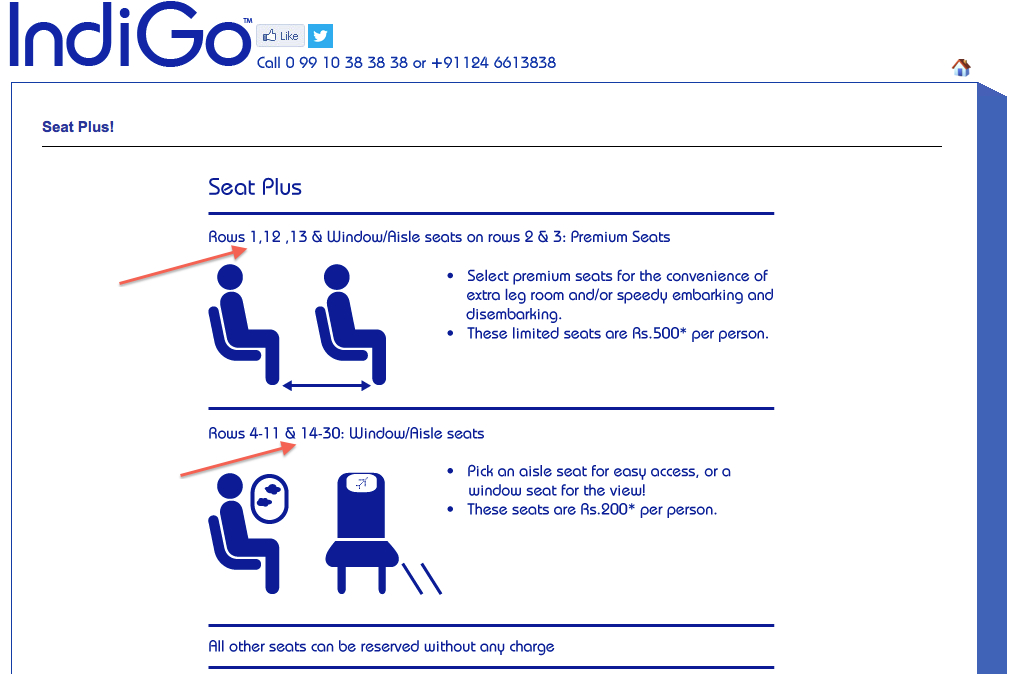In June last year, India’s civil aviation regulator the Directorate General of Civil Aviation (DGCA) allowed for unbundling of value added services by airlines, which allowed, amongst other things, airlines to charge for advance booking of preferred seating.
[bsu_pullquote]“Seat offered on opt-in charge basis shall not exceed 25% of the total seat configuration of the aircraft”– DGCA, Air Traffic Circular 3 of 2013, clause 3.4[/bsu_pullquote]Initially airlines went berserk charging a fee on virtually all the seats in their aircraft. The resultant hue and cry forced the powers that are, to act. So on June 27, 2013, the DGCA issued Air Transport Circular 3 of 2013 (embedded at the end of the article), which specified under clause 3.4 “Seat[s] offered on opt-in charge basis shall not exceed 25% of the total seat configuration of the aircraft. Middle seats shall not be offered for preferential seating except for the seats in the first row and the emergency exit row”.
All airlines in the country seem to be following the DGCA rules, save one. The nation’s largest domestic carrier, IndiGo.
A typical Boeing 737-800 seats 189 passengers in a single class configuration (32 rows of 6 seats each + 1 row of 3 seats). An Airbus A320 which IndiGo flies seats 180 (30 rows of 6 seats each). Both the other budget carriers, SpiceJet and GoAir follow the conditions of the circular, limiting themselves to 25 per cent of total aircraft capacity, by offering for sale only the front portion of the aircraft.
However IndiGo, under its ‘Seat Plus‘ program offers 126 seats for sale (2 windows + 2 aisles in 27 rows + all 6 seats in 3 rows). This works out to a full 70 per cent of its 180 seat aircraft capacity.

Bangalore Aviation contacted the airline to clarify our initial disbelief and an airline spokesperson informed us “IndiGo has represented to DGCA and been allowed to offer more seats for pre-assignment so long as the total number of such seats sold is less than 25 % of total seats”.
[bsu_pullquote align=”right”]“IndiGo has represented to DGCA and been allowed to offer more seats for pre-assignment so long as the total number of such seats sold is less than 25 % of total seats”
– IndiGo spokesperson[/bsu_pullquote]
Almost every dictionary of the English language defines the word offer as, to make available for sale or use i.e. prior to sale, not after the sale.
We repeatedly attempted to clarify with IndiGo spokespersons, the modalities of this permission and how is it implemented and operated? How does the airline ensure it does not cross the 25 per cent limit? How does the DGCA confirm that IndiGo is following the rules, even with the permission? There has been no response to our e-mails, phone calls, and SMSes.
If IndiGo has obtained a concession from the DGCA, we asked, other airlines are smart, why have they not made similar representations and obtained similar concessions? We contacted sources at the two competing budget carriers and both of them expressed surprise on our query. If the DGCA were to give such a blanket concession, wouldn’t it be easier for them to just amend the circular instead?
Which is easier to accept? IndiGo’s claims that the government regulator has given the airline permission to flout the government’s own regulations or IndiGo is playing it fast and loose using legal semantics to justify a violation of DGCA rules? Or is the answer somewhere in between?
Unfortunately we have not been able to get a clear answer.
Share your thoughts via a comment.
 Bangalore Aviation News, Reviews, Analysis and opinions of Indian Aviation
Bangalore Aviation News, Reviews, Analysis and opinions of Indian Aviation




I just bought a return on 6E – payed 700 rs extra (500 on going 200 return!)
Rahul Bhatia & Co is the new Naresh Goyal in town.
Being unusual lay speculative I would say, it lies somewhere in the middle. The airline mentioned it to the regulator who probably said they will look at it, take it from there….
United/Delta do similar things – for the base fare (or the lower fare classes) you can only select middle seats or aisle seats at the back (boarding is largely air bridge only). Windows, Aisles and Exit rows cost more.
IMO, the first row and exit rows are ok to charge more – aisle and window seats is pushing it!